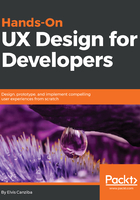
The discover stage
In the discover stage, we, as a team, will try to figure out what pieces of the product we are going to build are missing, what information we need to get started, and what people actually want our product to solve for them.
In this stage, it is important that we validate and remove the assumptions, and then present correct and accurate data to our team.
Do not make the wrong conclusion. This stage is not the same as the first stage where we were just doing discovery and planning. In the first stage, we were trying to get an initial idea about the product from the client before we start planning for it; here, we are doing deeper research about the product itself, involving real users.
Usually, things to do during this stage are: conduct field studies, meet our users, have conversations with them, note their troubles with our product, watch how they solve the problem, ask what they need, and, most importantly, observe and listen to them.
Also, it is a good idea during this stage to perform interviews with our category of users and run diary studies to understand our user's information needs and behaviors.
It is also good to interview the stakeholders to understand their business requirements, and interview other department teams as well by getting some answers from them, such as what is their most frequent problem, their worst problem, and what makes them angry or upset during the process of solving that specific problem.
Earlier, I mentioned that there are different methodologies that fall under each of these steps. In the discover phase, the top UX research methods most frequently used are as follows:
- Field study
- Diary study
- User interview
- Stakeholder interview